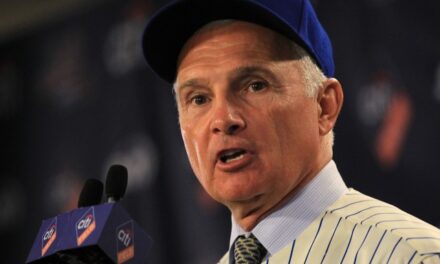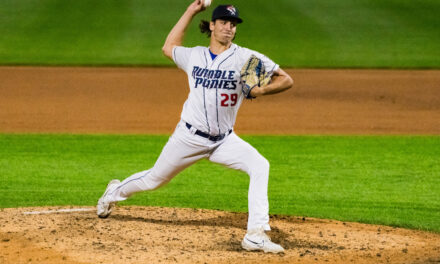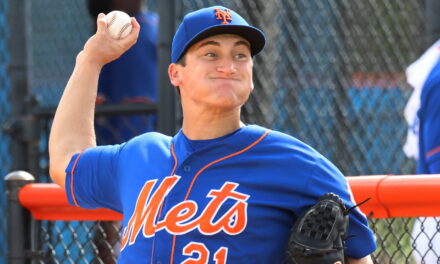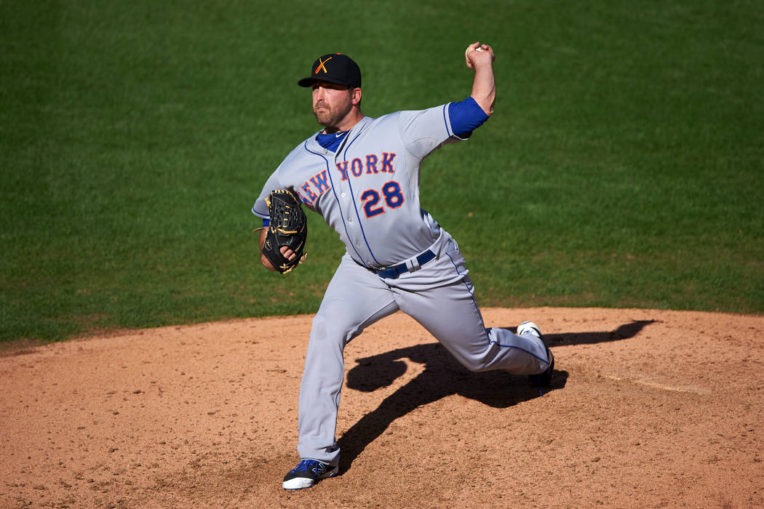
Photo Credit: Mike Janes/Four Seam Images
Kyle Regnault wasn’t drafted and rather started his career with the Worcester Tornadoes of the Canadian-American Association in 2012. He underwent Tommy John surgery after his first two years in college, but was still recovering from it after he was finished.
“I was still recovering,” Regnault said in 2015 according to MLB.com. “Tough to get signed when you are only throwing that much. So I went to a couple of workouts after my college career finished up and ended up hooking up with an indy league team.”
He spent 2012-2014 in independent ball mostly as a reliever before being signed by the Mets in 2015.
He put up two solid seasons for the Mets. In 2016 he posted a 3.18 ERA, 1.306 WHIP, and 9.5 SO/9 in 22 games (three starts) between three levels; mostly Double-A. He performed even better in 2017 as he had a 2.78 ERA, 1.299 WHIP, and 9.2 SO/9 innings in 45 appearances between Double-A and Triple-A.
The reason why he may find himself on the Mets’ 40-man roster and later the 25-man roster sometime during the 2018 season is in part his performance in Triple-A last season.
The ultimate test for any pitcher in the Mets system is how they fare in Triple-A Las Vegas. While it’s a pitcher’s nightmare, Regnault pitched to a 3.28 ERA, 1.419 WHIP, and 8.8 SO/9 in 49.2 innings across 34 appearances.
Regnault held righties to only a .573 OPS while he was no slouch against lefties holding them to a .655 OPS in 2017. His 2017 performance was enough to get him a spot in the Mets contingent sent to the Arizona Fall League.
All Regnault did was flat out dominate the AFL in 12.2 innings with a 0.71 ERA that ranked him third in the league. He also struck out 17 batters compared to only three walks and nine hits.
The AFL performance will certainly put Regnault in the ear of Mets brass and I would expect to see him in major league camp come February. The Mets currently only have Jerry Blevins as a guaranteed lefty in the pen meaning Regnault could battle Josh Smoker and Matt Purke for the second lefty role.
Regnault isn’t your typical bullpen guy when you consider he still throws four pitches. He had a fastball in the low 90’s, hard slider that really could be called a cutter, an overhand curve and a changeup he doesn’t use much out of the pen.
MMN – First off thanks for talking to me and congrats on what has been a great season. What was it like going from the Eastern League to pitching in the Pacific Coast League and what adjustments did you have too make?
Kyle – No problem, and thank you! I think the biggest adjustment had to be throwing more quality strikes, both early and late in counts. The hitters in AAA seemed to have a better approach and better idea of the strike zone, they also seemed be more aggressive early in counts, so throwing first pitch quality strikes was very important to my success. Those hitters were also more selective late in counts, so it was important to throw quality two strike pitches as well.
MMN – Did pitching in the thin air of Vegas make you change any previous approach towards hitters?
Kyle – The ball does seem to fly a little more out there with the thin air and wind, but i never felt like it caused me to change my approach. Pitching down in the zone is one of the keys to success in my opinion regardless of the environment, along side changing eye levels throwing up in the zone, I feel like they work off each other. Especially if a hitter has a weakness up in the zone, The environment would never deter me from exploiting that.
MMN – What has it been the AFL experience been like for you? Does the team do stuff as a team outside of the game itself?
Kyle – It was awesome, we had a great group of guys. Very similar to the group i was with in 2015 with Salt River. Everyone is focused on getting better and working on the tools and skills they need to have success at the next level. Outside of baseball, we have definitely been taking advantage of the nice weather in Scottsdale so far. A lot of golf courses around, also, hiking camelback mountain has been pretty popular on off days.
MMN – What are a few things you’re working on personally to take the next step and make it to the big leagues?
Kyle – I really believe it’s all about preparation, execution and consistency. I’ve learned over the years that every day is an opportunity to better yourself, whether it be in a game or practice environment. For me, I’m always striving to have more consistency with every pitch I throw. Being able to throw a pitch where you want it in certain situations is the name of the game.
I have incorporated daily routine, working up and down the slope, that has really helped my delivery become more consistent. If you look at all the pitchers that have had successful careers, none of them have the same mechanics or release points. It’s about finding the one that works for you and being able repeat it. so that has been a major focal point for me.
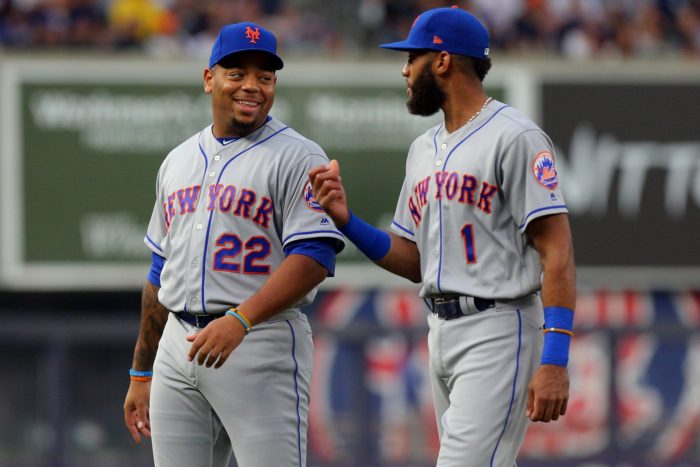
MMN – Who are the toughest hitters you’ve faced this year and why?
Kyle – There were a lot of good hitters I faced this year, but I’d say, Christian Walker and Oswaldo Arica were two of the toughest. Both have power that can hurt you and also have solid approaches that allowed them to fight off pitches, and get hits when they fell behind in counts. Both were tough outs all year. I’m just happy to have had Dominic Smith and Amed Rosario playing behind me this season, because In my opinion they were the two toughest outs in the league.
MMN – What do you think has been the key for you to be able to be successful going from Indy Ball all the way to the top of the minors? Who are some coaches/players that have helped influenced that success along the way?
Kyle – I feel that persistence has been a huge key to success for me. My path to where I am now, hasn’t been the most common or easiest, but, being able to handle and learn from failure or adversity, has been key for me.
I would have to say my biggest influence has been Phil Regan. Within a few months of working with Phil my first year with the Mets, he had cleaned up my delivery, allowing me to gain a few ticks of velocity and throw more strikes. But he also had a big impact on my mental part of the game. If you ever have a conversation with Phil, you’ll soon realize he is one of the nicest guys out there, but when it comes time to compete, he’s an animal, and loves to win. Having him as a pitching coach was an eye opening experience and really helped me gain that attack the zone-aggressive mentality.
MMN – When you were stuck in Indy ball did you ever contemplate retiring and what is the major difference between Indy Ball and the minors (not just on the field, pay/facilities, etc.).
Kyle – The thought of retiring had never crossed my mind, as crazy as it sounds. Missing almost three years in college due to academic transfer rules and Tommy John surgery, I got a late start in my professional career, starting Indy ball at age 23.
Even after playing three years of Indy ball, without getting signed to an affiliated organization, I always felt I had the ability to compete in the major leagues, I just haven’t gotten that one break yet. (Little did I know It would be meeting Phil Regan at the golf course). There are many differences between Indy ball and affiliated baseball. Some more obvious than others. The biggest difference I would say is the opportunity presented in affiliated baseball.
The facilities in minor league baseball are a little better than Indy ball teams, which would be expected. The organizations are more structured towards player development whereas Indy ball is more about performing. But one thing about Indy ball sticks out to me, and that is the heart and passion that Indy ball players possess. Indy ball is full of talented players, making less money than most in affiliated organizations, but they go out there every night and compete, without knowing if they’ll get that chance. They can’t just have a decent year and hope to get moved up to AA or AAA the next season.
Baseball is one the toughest sports to play, at any level, but I will always have the up most respect for Indy ball grinders.
MMN – You’ve played in a ton of cities, what are some of your favorites and why?
Kyle – I have to say I’ve enjoyed many of the cities I’ve played in over the years, but playing in Quebec City was special. It was an out of comfort zone experience because everyone speaks French, so I was almost forced to “partially” learn the language to be able to communicate. The team received overwhelming support which made it a fun environment to play in. But I’ve heard a lot of good things from players that are currently in New York and they love the fans, so I’m hoping to experience that In the near future.
MMN – Thanks again for your time and congrats on continued success in the AFL.


